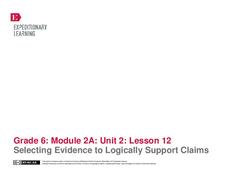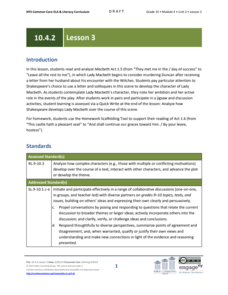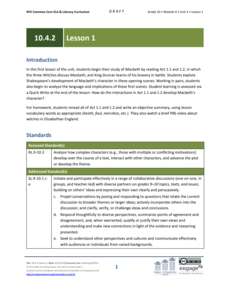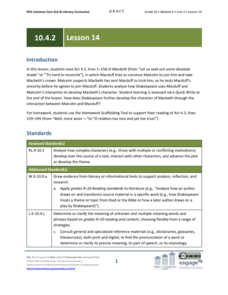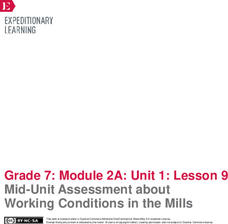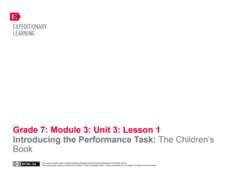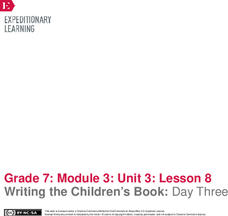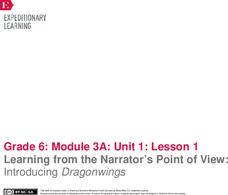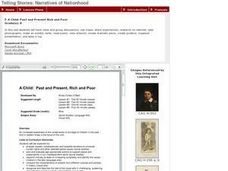EngageNY
Selecting Evidence to Logically Support Claims
It's time to make a rule sandwich! After exploring the writing assignment's rubric and analyzing a model essay, learners are guided through the prewriting phase using the sandwich technique. Pupils create their sandwich addressing the...
EngageNY
Grade 10 ELA Module 4: Unit 2, Lesson 7
One sentence, so much meaning. Scholars analyze a quote from Act 2.3 of Shakespeare's Macbeth and explore the plot in a jigsaw discussion.
EngageNY
Grade 10 ELA Module 4: Unit 2, Lesson 4
Ambition, murder, nontraditional gender roles ... some problems just can't be fixed in marriage counseling. Learners discuss the relationship between Macbeth and Lady Macbeth. As a culminating activity, pupils analyze how the characters'...
EngageNY
Grade 10 ELA Module 4: Unit 2, Lesson 3
How does Lady Macbeth's ambition help advance the plot of Shakespeare's Macbeth? Scholars explore the topic using discussion and a jigsaw activity. Next, they complete a quick write to analyze how Shakespeare develops Lady Macbeth's...
EngageNY
Grade 10 ELA Module 4: Unit 2, Lesson 1
What do readers discover about a character within the first few sections of a text? Pupils begin reading Shakespeare's Macbeth and analyze the language in the first few scenes of the play. They also demonstrate understanding with a Quick...
EngageNY
Reading Proficiently and Independently: The Power of Setting Goals
Scholars reflect upon their reading strengths and challenges to create personal reading goals. Participants use goal-setting verbiage in an accordion-style graphic organizer, a first step in writing a letter that details their reading...
EngageNY
Grade 10 ELA Module 4: Unit 2, Lesson 14
How does Shakespeare further develop Macbeth's character using the interaction between Macduff and Malcolm? Pupils write responses to the question. They continue their analysis of Macbeth with a masterful reading and guided whole-class...
EngageNY
Grade 10 ELA Module 4: Unit 2, Lesson 13
Lady Macduff uses a metaphor to suggest that her husband does not possess the courage of even a tiny, short-winged bird—ouch! Using the resource, pupils discover Act 4.2 of Shakespeare's Macbeth. Using reading, writing, and discussion,...
EngageNY
Grade 10 ELA Module 4, Unit 2, Lesson 23
Withered, wild, and bearded are three adjectives that describe the Witches from Shakespeare's Macbeth. Scholars view paintings and discuss how different artists depict the witches. Pupils also complete a Quick Write to analyze Henry...
EngageNY
Grade 10 ELA Module 4: Unit 2, Lesson 18
Macbeth describes life as a light and a candle, suggesting it is fleeting and meaningless. Using the resource, scholars engage in an evidence-based discussion and complete a Quick Write about Shakespeare's use of figurative language in...
EngageNY
Reading Shakespeare: Understanding Shakespeare’s Language
Pupils participate in a drama circle to read Shakespeare's A Midsummer Night's Dream aloud. They work with partners to discuss Shakespeare's use of language and analyze how specific lines of dialogue within the play help propel the...
EngageNY
Mid-Unit Assessment about Working Conditions in the Mills
Pupils demonstrate their knowledge of how setting impacts character development by completing a mid-unit assessment based on Katherine Paterson's novel Lyddie. They answer multiple-choice questions and cite textual evidence to explain...
EngageNY
Analyzing Textual Evidence: Working Conditions in the Mills
Deafening, dusty, debris. Such were the working conditions in the 1800s textile industry as portrayed in Katherine Paterson's novel Lyddie. Scholars watch a short video clip about life and work in the mills. Next, they work with partners...
EngageNY
Forming Evidence-Based Claims: Should Lyddie Sign the Petition?
Pupils reread selected passages from Katherine Paterson's novel Lyddie. After they finish, individuals gather textual evidence supporting whether Lyddie should sign a controversial petition and record their findings on graphic organizers.
EngageNY
Introducing the Performance Task: The Children’s Book
Using a Venn diagram, class members generate similarities and differences between narratives and summaries. Next, pupils co-create an anchor chart to capture their thinking about how an author zooms in on a particular part of a story.
EngageNY
Discussing and Identifying Themes: What Makes a Good Children’s Book?
Working in small groups, scholars look closely at a children's book to evaluate narrative techniques. Next, they complete a Children's Book Scavenger Hunt worksheet to analyze the literary elements of their selected stories.
EngageNY
Preparing for the Mid-Unit Assessment: Planning the Children’s Book
Pupils complete a My Children's Book Plan worksheet to carefully prepare for a narrative writing project. Scholars also continue working in their groups from lesson plan two, using their scavenger hunt worksheets to discuss what makes a...
EngageNY
End of Unit Assessment and Independent Reading Review
Reader, writer, illustrator ... scholars wear many hats! Pupils become experts in recommending books to their classmates as they write reviews of their independent reading books. Next, after finishing the second draft of their children's...
EngageNY
Writing the Children’s Book: Day Three
Illustrations are a key feature of children's books. Using the resource, pupils learn about adding illustrations to their children's books. Next, as they complete their storyboards and work on their second drafts, they consider their...
EngageNY
Coda: What Gives My Story Power? Celebrating Student Work
It's time for a celebration! Scholars go on a gallery walk around the classroom to view their peers' completed illustrated children's stories. Using sticky notes, pupils provide feedback about the powerful elements they find in their...
EngageNY
Learning from the Narrator’s Point of View: Introducing Dragonwings
Journey into the past with Laurence Yep's Dragonwings. Scholars complete anchor charts to analyze techniques the author uses to develop the narrator's point of view in his novel. As they read, pupils also complete word catchers to track...
Curated OER
That's Moor Like It!
How do modern adaptations of Shakespearean plays relate to their original source material? Middle and high schoolers focus on Shakespeare's play Othello and its screen adaptation "O" to explore how modern film adaptations of Shakespeare...
Curated OER
A Child: Past, and Present, Rich and Poor
Ninth graders study the topic of children's rights. They examine works of art, and pieces of literature which describe how these rights have evolved over time. Pupils pick up a pen, and write an editorial piece to a ficticious newpaper...
Curated OER
Acadians Through the Portrait
Another in the series of Canadian Culture lesson plans is here for you. In it, learners are invited to study the history of the Acadians; a segment of Canadian society for many generations. They utilize the images of Robert Harris, and...
Other popular searches
- English Literature Genres
- 6 8 English Literature
- Old English Literature
- English Literature History
- Olde English Literature
- English Literature Unit
- English Literature O Level
- English Literature Form
- Older English Literature
- Early English Literature
- English Literature Unit 13
- English Literature Canadian


